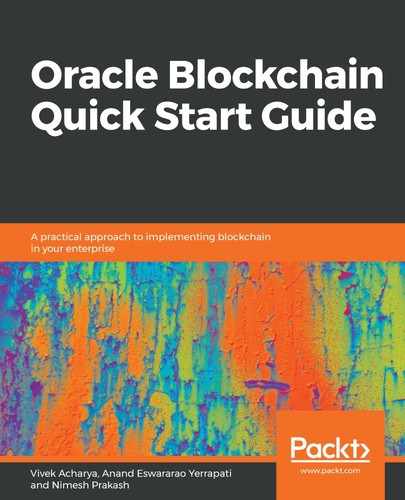Before we jump into HLF architecture and its components, let's first walk though a conceptual view and learn a number of important terms. Read this section to grasp some basic knowledge by means of an example and, after reading the architecture and components, revisit this section to further affirm your understanding of HLF.
The KonsensusChain organization decides to create a product chain (a blockchain business network named ProductChain) to enable producers and retailers to enter into transactions. In addition, it will allow the regulatory authority to validate the legality of the products as well. Organization KonsensusChain will act as the founder organization and will not participate in any transactions. However, it will set up the blockchain network, develop user interfaces, chaincode applications, and will further maintain and operate the business network (consortium). This is a founder-initiated model of a blockchain network, based on HLF, where participating organizations have created a consortium. In this sample, a dApp is not fully offered by the founder. dApps are individually built by the organization. However, they use SDK, REST APIs, and other integration methods to connect with the business blockchain network and execute transactions.
The following are the different organizations intending to be part of the blockchain network:
- Producer organization: Identified as organization 1 (O1), this is an organization that produces certain products and sells them to retailers. The regulatory authority further verifies the legality of those products. The certificate authority (CA) for producer organization O1 is CA 01.
- Retailer organization: Identified as organization 2 (O2), this is an organization that buys products from producer organization O1 and sells them on to its consumers. The CA for retailer organization O2 is CA O2.
- Retailer organization: Identified as organization 1 (O3), this is an organization that buys products from producer organization O1 and sells them on to its consumers. The CA for retailer organization O3 is CA O3.
- Regulatory authority: Identified as a regulatory organization (O4), this is a regulatory authority that verifies the products and stamps the legality of produce.
- Founder organization: KonsensusChain.com is the founding organization, identified as organization 5 (O5). All the retailers and producers have agreed to employ O5 as the founder organization for the ProductChain blockchain network (the fictitious name of the blockchain network).
The following are the requirements of this blockchain-based business network (ProductChain):
- Requirement one: The producer organization (O1) wants to have private transactions and communications with the retailer organization (O2), as they have agreed on a specific rate for certain products and want to have transaction privacy
- Requirement two: Similarly, the producer organization (O1) wants to have private transactions and communications with the retailer organization (O3), as they have agreed on certain discounts and payment terms, which they want to keep secret
The following is a conceptual diagram of the business network that will be referred to in this section:

